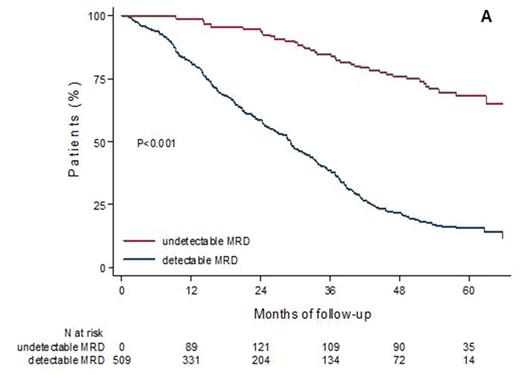Abstract

Background: Very significant improvements in survival have been observed in the past decade in multiple myeloma (MM). This improvement is mainly due to the availability of new effective drugs, that also improved the response rate. With such combinations, the CR rate increased from a few percent to up to 80%. Thus, CR rate cannot be anymore a realistic endpoint for trials, and more sensitive techniques are mandatory to try to monitor the real remaining disease burden. We used a very sensitive technique, Immunoglobulin gene next generation sequencing, in a prospective trial to quantitate minimal residual disease (MRD), and to correlate with PFS and OS
Methods: The IFM2009 trial randomized 700 patients to received high-dose melphalan or not following a RVD induction. All the patients did then receive a 12-month lenalidomide maintenance. MRD was assessed before and after maintenance using the ClonoSeq kit (Adaptive Biotechnologies, Seattle, WA). This kit enables to detect 1 tumor cell in 1,000,000 bone marrow cells.
Findings: MRD was evaluated in 269 patients who achieved at least VGPR. Patients who did not achieve VGPR were considered MRD positive. First, we found that sensitivity is very important, patients with a MRD level below 10-6 presenting a significant better PFS than patients not achieving this level. We thus defined MRD negativity as patients with a MRD lower than 10-6. Using this cutoff, at a median follow-up of 55 months, the median PFS for patients achieving MRD negativity was not reached, versus 29 months for patients who did not reach MRD negativity (Figure). Second, we analyzed the results according to treatment arm. If more patients in the transplant arm achieved MRD negativity, we did not observe any difference in PFS in patients with MRD negativity, meaning that patients able to achieve MRD negativity without transplant present a similar outcome than those transplanted. Third, we looked at the role of high risk cytogenetics. HR patients who achieved MRD negativity presented a significantly better outcome than standard risk patients who did not achieve MRD negativity, meaning that HR is a dynamic concept that should be reevaluated during treatment. Fourth, we did also observe a significantly longer OS in patients who achieve MRD negativity.
Conclusions: We showed that MRD could (should?) be considered as a novel surrogate biomarker for trial evaluation. This study showed that the best sensitivity is associated with the best discrimination in PFS and OS, and suggested that 10-6 should be the optimal cutoff.
Avet-Loiseau: Celgene, Janssen, Amgen, Bristol-Myers Squibb, Sanofi: Honoraria, Speakers Bureau; Janssen, Sanofi, Celgene, Amgen: Consultancy; Celgene, Janssen: Research Funding. Moreau: Celgene, Janssen, Takeda, Novartis, Amgen, Roche: Membership on an entity's Board of Directors or advisory committees; Celgene: Consultancy, Honoraria; Takeda: Honoraria; Amgen: Honoraria; Millennium: Consultancy, Honoraria; Bristol-Myers Squibb: Honoraria; Janssen: Consultancy, Honoraria; Novartis: Consultancy, Honoraria; Onyx Pharmaceutical: Consultancy, Honoraria. Attal: Celgene: Consultancy, Research Funding; Amgen: Consultancy, Research Funding; JANSSEN: Consultancy, Research Funding; Sanofi: Consultancy.
Author notes
Asterisk with author names denotes non-ASH members.

This icon denotes a clinically relevant abstract


This feature is available to Subscribers Only
Sign In or Create an Account Close Modal